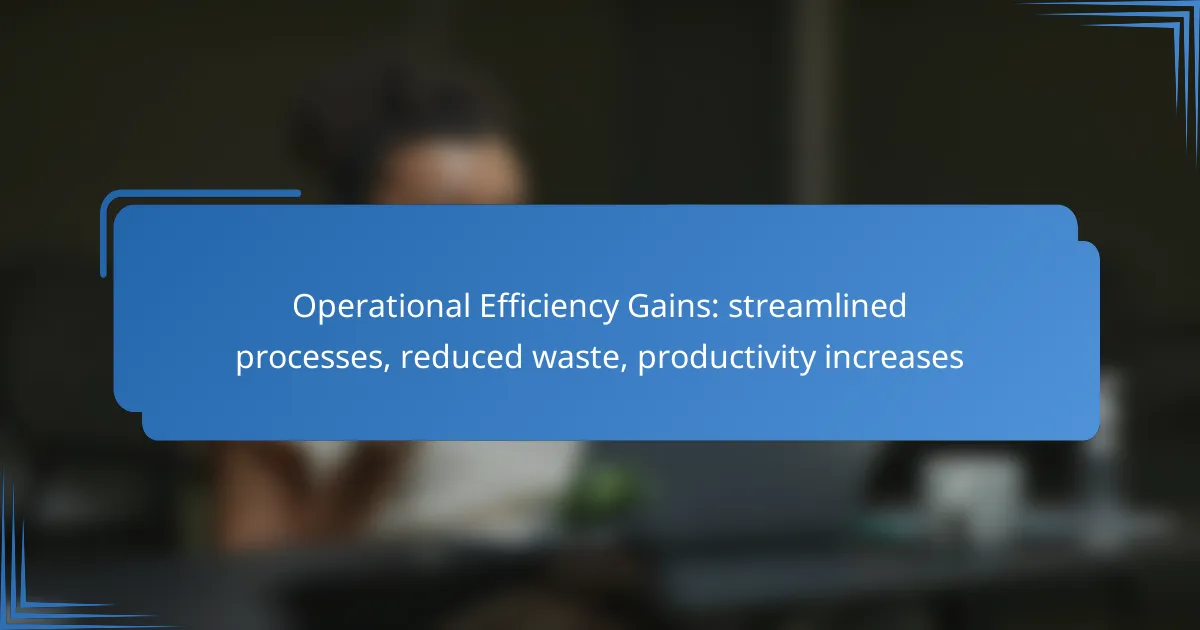Achieving operational efficiency is crucial for e-commerce businesses in Australia, as it involves streamlining processes, reducing waste, and enhancing productivity. By implementing automation tools, optimizing supply chain management, and leveraging data analytics, companies can simplify workflows and focus on value-added activities. These strategies not only lower costs but also significantly improve customer satisfaction and overall performance.

How can e-commerce businesses achieve operational efficiency in Australia?
E-commerce businesses in Australia can achieve operational efficiency by streamlining processes, reducing waste, and increasing productivity through various strategies. Key approaches include implementing automation tools, optimizing supply chain management, and utilizing data analytics for informed decision-making.
Implementing automation tools
Automation tools can significantly enhance operational efficiency by reducing manual tasks and minimizing errors. E-commerce businesses should consider software for inventory management, order processing, and customer service to streamline workflows.
For example, using chatbots for customer inquiries can free up staff time while ensuring 24/7 support. Additionally, automating inventory updates can help maintain accurate stock levels, reducing the risk of overstocking or stockouts.
Optimizing supply chain management
Effective supply chain management is crucial for e-commerce efficiency, as it directly impacts delivery times and costs. Businesses should assess their logistics partners and consider local suppliers to reduce shipping times and expenses.
Implementing just-in-time inventory practices can also minimize waste and storage costs. Regularly reviewing supplier performance and negotiating better terms can lead to significant savings and improved service levels.
Utilizing data analytics for decision-making
Data analytics enables e-commerce businesses to make informed decisions based on customer behavior and market trends. By analyzing sales data, companies can identify which products are performing well and adjust their inventory accordingly.
Additionally, leveraging analytics tools can help in forecasting demand, optimizing pricing strategies, and personalizing marketing efforts. Businesses should invest in user-friendly analytics platforms to gain actionable insights that drive efficiency.

What are the benefits of streamlined processes?
Streamlined processes enhance operational efficiency by simplifying workflows, minimizing waste, and boosting productivity. These improvements lead to significant benefits, including reduced costs and increased customer satisfaction.
Reduced operational costs
Streamlined processes can lead to lower operational costs by eliminating unnecessary steps and optimizing resource allocation. For instance, businesses may reduce labor costs by automating repetitive tasks, which can save hundreds to thousands of dollars annually depending on the scale of operations.
Additionally, minimizing waste in materials and time can further decrease expenses. Companies should regularly assess their processes to identify bottlenecks and inefficiencies, allowing for targeted improvements that can yield substantial savings.
Improved customer satisfaction
Streamlined processes contribute to improved customer satisfaction by enhancing service delivery and product quality. When operations are efficient, customers experience faster response times and fewer errors, which can lead to higher retention rates and positive reviews.
To maximize customer satisfaction, businesses should focus on continuous feedback loops, allowing them to adapt processes based on customer needs. Regularly engaging with customers and analyzing their feedback can help identify areas for further improvement, ensuring that the streamlined processes align with their expectations.

How does reduced waste impact productivity?
Reduced waste directly enhances productivity by streamlining operations and optimizing resource use. When waste is minimized, organizations can focus their efforts on value-added activities, leading to improved efficiency and output.
Minimized excess inventory
Minimizing excess inventory is crucial for reducing waste and improving productivity. By maintaining optimal stock levels, businesses can avoid the costs associated with overstocking, such as storage fees and potential obsolescence. Implementing just-in-time inventory systems can help achieve this balance.
For example, companies can use inventory management software to track stock levels in real-time, ensuring they only order what is necessary. This approach not only cuts down on waste but also frees up capital that can be reinvested into other areas of the business.
Enhanced resource allocation
Enhanced resource allocation involves strategically distributing resources to maximize efficiency and minimize waste. By analyzing workflows and identifying bottlenecks, organizations can ensure that their resources—whether human, financial, or material—are used where they are most effective.
For instance, conducting regular assessments of team performance can reveal areas where skills are underutilized. By reallocating tasks or providing targeted training, companies can boost productivity while reducing the waste of time and effort.

What strategies increase productivity in e-commerce?
To enhance productivity in e-commerce, businesses can adopt various strategies such as employee training and development, along with implementing lean management practices. These approaches focus on optimizing workflows, minimizing waste, and empowering staff to perform at their best.
Employee training and development
Investing in employee training and development is crucial for boosting productivity in e-commerce. Well-trained employees are more efficient, make fewer mistakes, and can adapt to new technologies and processes quickly. Regular training sessions, workshops, and online courses can help staff stay updated on industry trends and best practices.
Consider implementing a structured onboarding program for new hires, which can include mentorship and hands-on training. This approach ensures that employees feel confident in their roles and understand the company’s operational goals. Additionally, offering ongoing professional development opportunities can lead to higher employee satisfaction and retention.
Implementing lean management practices
Lean management practices focus on reducing waste and improving efficiency, making them ideal for e-commerce operations. By identifying and eliminating non-value-added activities, businesses can streamline processes and enhance productivity. Techniques such as value stream mapping can help visualize workflows and pinpoint areas for improvement.
Adopting a just-in-time inventory system can also support lean principles by reducing excess stock and minimizing storage costs. Regularly reviewing and refining processes ensures that the organization remains agile and responsive to market demands. Businesses should encourage a culture of continuous improvement, where employees are empowered to suggest changes that enhance efficiency.

What role does technology play in operational efficiency?
Technology significantly enhances operational efficiency by automating processes, reducing waste, and boosting productivity. By implementing the right tools, businesses can streamline workflows and optimize resource allocation, leading to improved performance and cost savings.
Integration of e-commerce platforms
Integrating e-commerce platforms allows businesses to manage sales, inventory, and customer interactions more effectively. This integration can lead to faster order processing and improved customer satisfaction, as data flows seamlessly between systems.
Consider using platforms like Shopify or WooCommerce, which offer built-in tools for analytics and customer management. These platforms can reduce manual data entry and errors, saving time and resources.
To maximize benefits, ensure that your e-commerce platform is compatible with existing systems and provides real-time data updates. This will help maintain accuracy and enhance decision-making.
Adoption of cloud-based solutions
Cloud-based solutions facilitate operational efficiency by providing scalable resources and remote access to data. Businesses can leverage these solutions to enhance collaboration and reduce IT costs associated with maintaining on-premises infrastructure.
Popular cloud services like Amazon Web Services (AWS) and Microsoft Azure offer flexible pricing models, allowing businesses to pay only for what they use. This can lead to significant savings, especially for small to medium-sized enterprises.
When adopting cloud solutions, prioritize security and compliance with regulations relevant to your industry. Regularly review your cloud strategy to ensure it aligns with your operational goals and evolving technology landscape.

How can businesses measure operational efficiency gains?
Businesses can measure operational efficiency gains by analyzing various metrics that reflect productivity, waste reduction, and process improvements. Key methods include tracking key performance indicators (KPIs) and gathering customer feedback to assess satisfaction levels.
Key performance indicators (KPIs)
KPIs are quantifiable measures that help businesses evaluate their operational efficiency. Common KPIs include cycle time, throughput, and cost per unit, which provide insights into how effectively resources are being utilized.
To effectively measure these indicators, businesses should establish baseline metrics before implementing changes. Regularly reviewing these KPIs can help identify trends and areas for improvement, allowing for timely adjustments to strategies.
For example, a manufacturing company might track the number of units produced per hour to assess productivity. A typical range for high-performing operations might be in the low hundreds of units, while less efficient processes could yield significantly lower outputs.
Customer feedback and satisfaction surveys
Customer feedback and satisfaction surveys are essential tools for measuring operational efficiency gains from the consumer’s perspective. They provide insights into how well a business meets customer needs and identifies areas where processes may be lacking.
Implementing regular surveys can help businesses gauge customer satisfaction levels and pinpoint specific pain points. For instance, a retail business might find that long checkout times lead to dissatisfaction, prompting a review of their point-of-sale processes.
To maximize the effectiveness of feedback, businesses should aim for a response rate of at least 20-30% on surveys. This ensures a representative sample of customer opinions, leading to more accurate assessments of operational efficiency.

What are the prerequisites for improving operational efficiency?
To enhance operational efficiency, organizations must first evaluate their existing processes and secure commitment from leadership. These prerequisites ensure that any changes made are informed and supported at all levels, facilitating smoother implementation.
Assessment of current processes
Assessing current processes involves a thorough review of workflows, resource allocation, and output quality. This evaluation helps identify bottlenecks, redundancies, and areas where waste occurs, allowing for targeted improvements. Techniques such as process mapping or value stream analysis can be effective in visualizing these elements.
Consider conducting employee surveys or focus groups to gather insights on inefficiencies. Engaging staff who work directly with processes can reveal practical challenges and innovative solutions that management may overlook.
Commitment from leadership
Leadership commitment is crucial for driving operational efficiency initiatives. When leaders actively support and prioritize efficiency improvements, it fosters a culture of accountability and encourages employee buy-in. This commitment can manifest through regular communication, resource allocation, and setting clear performance goals.
To maintain momentum, leaders should establish a framework for monitoring progress and celebrating milestones. Regular updates on efficiency gains can motivate teams and reinforce the importance of continuous improvement in operational practices.
